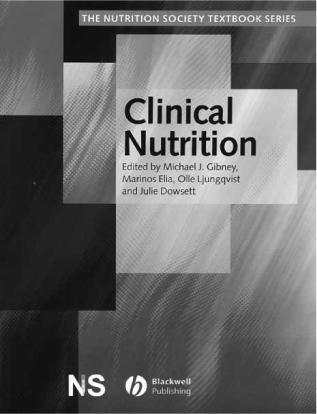Michael J. Gibney, Marinos Elia, Olle Ljungqvist and Julie Dowsett, eds. Oxford: Blackwell Publishing; 2005. 480 pp.
ISBN-10: 0-632-05626-6. ISBN-13: 978-0-632-05626-2. £30
“Clinical nutrition” is a new international textbook in clinical nutrition. It is the fourth volume in the Nutrition Society Textbook Series, and completes that suite of textbooks on nutrition. Together with the three previously published volumes, this is a textbook series covering the whole area of human and clinical nutrition and metabolism. The ambition for the series is high; according to the series foreword the reasoning behind the initiative to launch this series of human nutrition textbooks, designed for use worldwide, is that “having the best possible tools is an enormous advantage in teaching and learning”. The first volume, “Introduction to human nutrition”, addresses various student groups where nutrition is part of the training, sometimes to a minor degree. The second volume, “Nutrition and metabolism”, gives the basics of biochemistry and physiology on which the science of nutrition is founded. The third volume, “Public health nutrition”, covers a broad spectrum of nutritional issues in relation to public health. The current volume, “Clinical nutrition”, is intended for those with an interest in nutrition in the clinical setting: dietitians, doctors, nurses and other interested health professionals.
The book is divided into 25 chapters. The first part consists of general chapters. The first introductory chapter, by Marinos Elia, is on the principles of clinical nutrition. This chapter gives in 14 pages an overview of the subject in a clearer way than many others have managed in far more pages of text. If you read just one chapter in this book, I think that it should be this one. The following general chapters cover assessment of nutritional status, the clinical consequences and current management of overnutrition and undernutrition, the metabolic syndrome and eating disorders, and there is also a very interesting chapter on adverse reactions to food. The general part of the book concludes with chapters on nutrition support and nutrition and ethics.
This general introductory part comprises about one-third of the total page number. The major part of the book consists of organ-centred chapters, covering nutrition in relation to organ disease and within different clinical specialities. The 13 organ-centred chapters, taken together, give a thorough and comprehensive picture of the various aspects of nutrition in clinical medicine. There is also a chapter about water and electrolytes, and the final chapter of the book is a series of case studies presented by Simon Allison. These case studies present in an excellent way the application of the principles of nutritional diagnosis, assessment, treatment and clinical management.
This book gives the best description of the subject of clinical nutrition that I have come across so far. It has, compared with several other textbooks in human nutrition, a greater focus on medical aspects and the clinical care process. It should therefore be suitable as a textbook for education within this field. However, it should not be recommended for this purpose without some minor reservations. All chapters do not have the same depth and focus on the subject, and while the editorial co-ordination of 47 authors has generally worked very well, there are some shortcomings, for example the subject of diabetes, which is divided, somewhat unnecessarily in my view, between metabolic disease and pancreatic disorders. Otherwise, the chapters are well structured, with introductory key messages and a concluding part on future perspectives. The proof-reading has generally been done well, although some minor errors can still be found, as in the Harris--Benedict equation for the calculation of basal metabolic rate: it appears in two places in the text, in the chapter on undernutrition, where there is an error in the equation for females, and in the chapter on nutrition support, where it is correct.
The focus on clinical medical aspects, in itself a main strength of the book, inevitably displaces other aspects to some degree. Thus, basics of human nutrition, metabolism and nutritional methodology are not covered in this volume. References are made in the text to the other volumes in the series, and together they appear to fulfil the ambition to be a leading tool in teaching and learning. As a textbook in undergraduate studies this book therefore needs support from other sources, such as the other volumes in the Nutrition Society Textbook Series.
To sum up, this book, and the series in which it completes the suite of four textbooks in nutrition, is a most valuable addition to the literature. I think that it is a strong candidate in its intended use as a textbook in courses on clinical nutrition, for instance in the training of clinical dietitians. The book also makes a valuable contribution to the process of developing and improving the clinical management of disease-related nutritional disorders.
